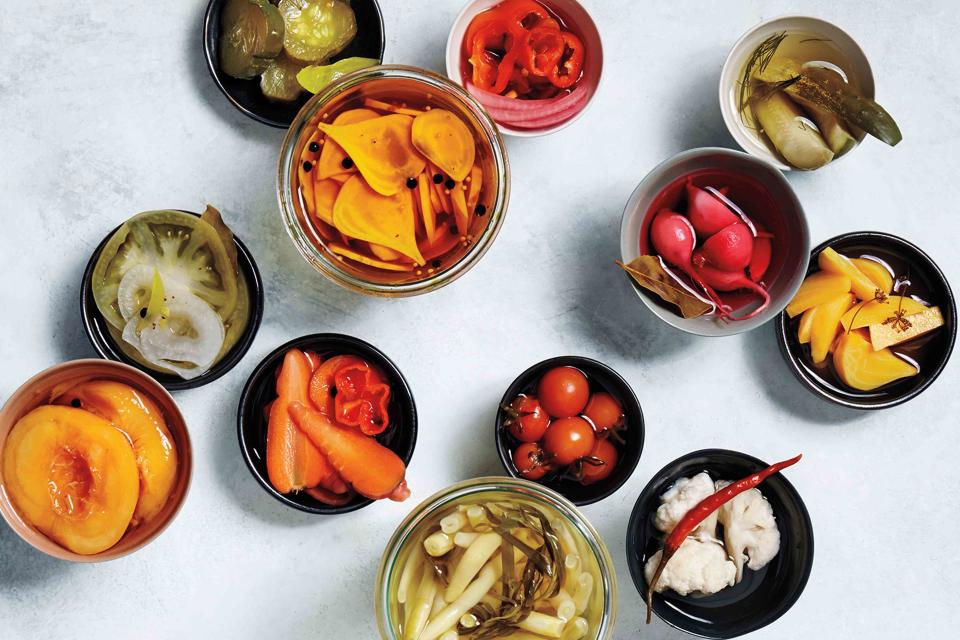The Difference Between Pickling and Fermenting, According to Experts
Both techniques make food sour and tangy, but they're not the same.

Christopher Testani
If you've used the terms "pickling" and "fermenting" interchangeably, you're not alone. These two techniques are often confused for each other, as both preserve food with deliciously tangy results. However, pickling and fermenting are not the same, as they affect food in different ways. Read on to learn the difference between pickling and fermenting, plus when to use each method at home.
Meet Our Expert
William Dissen, executive chef and owner of The Market Place in Asheville, N.C., and author of Thoughtful Cooking: Recipes Rooted In the New South
Hervé Malivert, chef and director of culinary affairs at the Institute of Culinary Education
Related: How to Make Kimchi
What Is Pickling?
Pickling is the process of immersing ingredients in an acidic brine, like vinegar or a salt brine, says William Dissen, executive chef and owner of The Market Place in Asheville, N.C., and author of Thoughtful Cooking: Recipes Rooted In the New South. This gives the food a sour, tangy flavor.
Shelf Stability
Although pickling can extend a food’s shelf life, the duration depends on the method. In pickling for preservation (or canning), a pressure cooker is used to sterilize and create an airtight seal in the jar of food, which makes it shelf-stable, says Hervé Malivert, chef and director of culinary affairs at the Institute of Culinary Education. In general, it can last for about one year when left unopened and stored at room temperature. Quick pickling, on the other hand, involves submerging food in vinegar and storing it in the refrigerator for about one week. It doesn't involve the canning process, so it won't last as long.
What Is Fermenting?
The process of fermenting also gives food a sour flavor. But unlike pickling, the sourness comes from a chemical reaction, rather than an acidic brine. Specifically, microorganisms (like yeast and bacteria) break down the carbohydrates in food. The technique also produces beneficial microbes, most notably Lactobacillus bacteria, which are beneficial for the gut.
Shelf Stability
The process of fermentation involves a chemical reaction that turns sugars into a variety of substances, including organic acids, alcohol, and carbon dioxide—all of which limit the growth of spoilage bacteria in food, says Malivert. "However, in most cases, fermentation alone can't produce something shelf-stable; almost all fermented products require canning or refrigeration [to be preserved]," says Malivert.
Pickling vs. Fermenting
"Both pickling and fermenting help tenderize food and enhance the flavor with saltiness and sourness," explains Dissen. The flavor of fermented foods tends to be more complex, leaning toward both umami and sour, says Malivert.
In terms of color and texture, pickled foods tend to look brighter, while fermented foods usually have a more muted appearance, he says. In either case, "it's important to store pickled and fermented foods in a cool, dark place to help them keep their color," says Dissen.
Are Fermented Foods Pickled?
Although many people use "pickling" to describe food preservation by either canning or fermenting, all fermented foods are technically not pickled, says Malivert. Pickling food means it's been packed unfermented in hot acidic brine, while fermented foods have undergone a chemical reaction.
When to Use Each
The best choice depends on your desired flavor profile, shelf stability, and nutritional benefits. If you're craving a crunchy and tangy snack, go for pickling (and can the food for a longer shelf life). If it's the umami sourness and gut benefits you're after, opt for fermenting.
What's more, you can pickle or ferment just about any fruit or vegetable, says Dissen—so there's plenty of room to experiment with techniques and ingredients.
Foods that are commonly pickled include crispy vegetables like cucumbers, carrots, and onions,
Those that are often fermented include cabbage and spicy peppers (think sauerkraut and hot sauce).
Read the original article on Martha Stewart.

